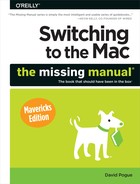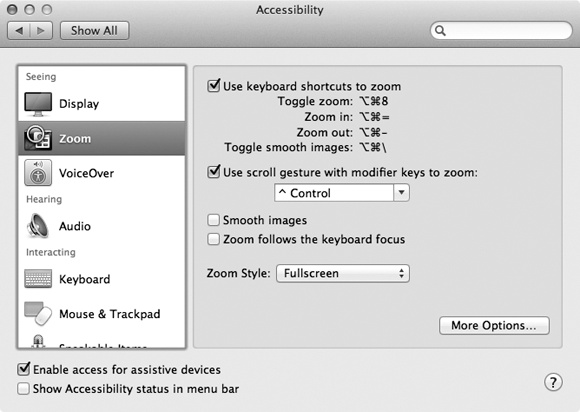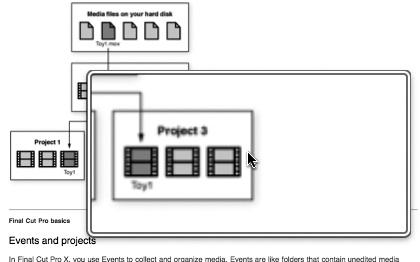The Accessibility panel (formerly Universal Access) is designed for people who type with one hand, find it difficult to use a mouse, or have trouble seeing or hearing. (These features can also be handy when the mouse is broken or missing.)
Accessibility is a huge focus for Apple. In fact, there’s a whole Apple Web site dedicated to explaining all these features: www.apple.com/accessibility. Here, though, is an overview of the noteworthiest features, broken down according to the tabs at the left side.
If you have trouble seeing the screen, then, boy, does OS X have features for you.
“Invert colors” swaps the colors of the screen, so that text appears white on black—an effect that some people find easier to read. (This option also freaks out many Mac fans who turn it on by mistake. They think the Mac’s expensive monitor has just gone loco. Now you know better.)
“Use grayscale” banishes all color from your screen. This is another feature designed to improve text clarity, but it’s also a dandy way to see how a color document will look when printed on a monochrome laser printer.
The “Enhance contrast” slider makes blacks blacker and whites whiter, further eliminating in-between shades and thereby making the screen easier to see.
At the bottom, you’ll find the Cursor Size slider. It’s a godsend not only to people with failing vision, but also to anyone using one of Apple’s large, super-high-resolution screens; as the pixel density increases, the arrow cursor gets smaller and smaller. This slider lets you make the arrow cursor larger—much larger, if you like—making it much easier to see.
This feature, shown in Figure 16-3, lets you enlarge the area surrounding your cursor in any increment. It’s just incredibly useful, incredibly often, especially if you have over-40 eyes.
Figure 16-3. You’ll be amazed at just how much you can zoom into the Mac’s screen using this Accessibility pane. In fact, there’s nothing to stop you from zooming in so far that a single pixel nearly fills the entire monitor. (That may not be especially useful for people with limited vision, but it can be handy for graphic designers learning how to reproduce a certain icon, dot by dot.)
Tip
If you have a laptop or a Magic Mouse, just using the Control-key trick described in the box on Zooming In, the Shortcut Way is a far faster and easier way to magnify the screen. It works even when this one is turned off.
To make it work, press Option-⌘-8 as you’re working. You can further adjust the magnification by pressing Option-⌘-plus (to zoom in) or Option-⌘-minus (to zoom out). With each press, the entire screen image gets larger or smaller, creating a virtual monitor that follows your cursor around the screen.
You’re offered an array of customization options. For example, you can substitute the Option or ⌘ key, if Control isn’t working out for you. And you can turn on a pixel-smoothing feature that adds a certain blurriness to the zoomed-in image. Finally, you can switch between Full Screen (the whole monitor is your view) or Picture-in-Picture (the zoomed-in portion stays within a picture-in-picture rectangle on the screen, as shown in Figure 16-4).
Figure 16-4. This inset window makes it easier for you to keep your bearings. It zooms into the screen only within this inset window.
If you click More Options, you can specify how you want to scroll around within your zoomed-in screen image. The factory setting, “Continuously with pointer,” is actually pretty frustrating; the whole screen shifts around whenever you move the cursor. (“So the pointer is at or near the center of the image” is very similar.) “Only when the pointer reaches an edge” is a lot less annoying and lets you use the cursor (to click buttons, for example) without sending the entire screen image darting away from you.
Tip
The sliders at the top of this dialog box limit the degree of zooming in and zooming out. However, even if you’ve adjusted them, you can always override your slider settings by pressing Option-⌘-plus or Option-⌘-minus.
When “Picture-in-picture” is turned on, the dialog box that appears when you click More Options is totally different. It offers these choices:
Stationary. The inset remains parked on the screen. You can’t move or resize it—at least not once you’ve left the Options dialog box.
Follow mouse cursor. The inset window follows your cursor around, as though you’re moving a high-tech magnifying glass over a map.
Tiled along edge. The magnified inset becomes much bigger—in fact, it becomes an enormous rectangular swath at the left side of your screen. The image scrolls as you move your cursor around.
Tip
One of the best options here is “Enable temporary zoom.” What that means is that at any time, in any program, you can summon the magnified-inset window at your cursor location by holding down your Control and Option keys together. (It works only if Zoom is turned on in Accessibility.) It’s a great way to dip into a magnified view of something on your screen, briefly.
VoiceOver makes the Mac read out loud every bit of text that’s on the screen. See Saving a report.
If you have trouble hearing the Mac’s sounds, the obvious solution is to increase the volume, which is why this panel offers a link to the Sound preferences pane.
Audio is especially important when the Mac tries to get your attention by beeping. For those situations, turn on “Flash the screen when an alert occurs” (an effect you can try out by clicking the Test Flash Screen button). Now you’ll see a white flash across the entire monitor whenever the Mac would otherwise beep—not a bad idea on laptops, actually, so that you don’t miss beeps when you’ve got the speakers muted.
The “Play stereo audio as mono” option is intended for people with hearing loss in one ear. This way, you won’t miss any of the musical mix just because you’re listening through only one headphone.
This option, new in Mavericks, controls the look of subtitles in movies, TV shows, videos, and podcasts you’ve bought, rented, or streamed from Apple. (Subtitles are an option in iTunes, QuickTime, and DVD Player.)
When you first click Captions, you can see that Apple has supplied you with three different caption styles—Default, Classic, and Large Text; each has its own font, color, and background color. If you click the ![]() button, though, you can whip up a new subtitle style to your own taste; you get an insane number of font, size, opacity, and color options.
button, though, you can whip up a new subtitle style to your own taste; you get an insane number of font, size, opacity, and color options.
A few videos have been subtitled specifically for deaf people. Those subtitles, called closed captioning or SDH (Subtitles for the Deaf and Hard of Hearing), are the same thing as regular subtitles, except that they also identify non-spoken sounds (“Glass breaking”) and who’s speaking (“Captain Picard: Engage!”). If you’d prefer to see these SDH captions instead of the regular ones, turn on “Prefer Closed Captions and SDH.”
This panel offers two clever features designed to help people who have trouble using the keyboard.
Sticky Keys lets you press multiple-key shortcuts (involving keys like Shift, Option, Control, and ⌘) one at a time instead of all together.
To make Sticky Keys work, first turn on Enable Sticky Keys. Then go to work on the Mac, triggering keyboard commands as shown in Figure 16-5.
If you press a modifier key twice, meanwhile, you lock it down. (Its onscreen symbol gets brighter to let you know.) When a key is locked, you can use it for several commands in a row. For example, if a folder icon is highlighted, you could double-press ⌘ to lock it down—and then type O (to open the folder), look around, and then press W (to close the window). Press the ⌘ key a third time to “un-press” it.
Tip
The checkbox called “Press the Shift key five times to turn Sticky Keys on or off” (click Options to see it) gives you the flexibility of turning Sticky Keys on and off at will, without even taking a trip to System Preferences. Whenever you want to turn on Sticky Keys, press the Shift key five times in succession. You’ll hear a special clacking sound effect alerting you that you just turned on Sticky Keys. (Repeat the five presses to turn Sticky Keys off again.)
Figure 16-5. Whenever you want to press a multiple-key keystroke like Shift-⌘-D, press them one at a time. You’ll see ghost images of these keys superimposed on your screen, as though to show you which keystrokes you’ve added to your temporary collection. To “un-press” a key you’ve already pressed, press it again twice.
Slow Keys, on the other hand, doesn’t register a key press at all until you’ve held down the key for more than a second or so—a feature designed to screen out accidental key presses.
If you click Options and then turn on “Use click key sounds,” you’ll hear a little typing sound each time you press a key—but none of these key presses registers unless you hold the key down for a moment. (Use the Acceptance Delay slider to govern this threshold.)
You hear a different sound when the Mac actually accepts the key press—and, of course, you see the letter you typed appear onscreen.
Mouse Keys is designed to help people who can’t use the mouse—or who want more precision when working in graphics programs. It lets you click, drag, and otherwise manipulate the cursor by pressing the keys on your numeric keypad. (It’s not very useful on keyboards that don’t have separate numeric keypads, like laptops.)
When Mouse Keys is turned on, the 5 key acts as the clicker—hold it down for a moment to “click the mouse,” do that twice to double-click, and so on. Hold down the 0 key to lock down the mouse button, and the period key to unlock it. (The amount of time you have to hold them down depends on how you’ve set the Initial Delay slider.)
Move the cursor around the screen by pressing the eight keys that surround the 5 key. (For example, hold down the 9 key to move the cursor diagonally up and to the right.) If you hold one of these keys down continuously, the cursor, after a pause, begins to move smoothly in that direction—according to the way you’ve adjusted the sliders called Initial Delay and Maximum Speed.
In Mavericks, Apple has made the Mac available to another category of fans: those whose physical skills are limited to very simple gestures, like puffing on an air pipe, pressing a foot switch, blinking an eye, or turning the head, for example. A hardware accessory called a switch lets you operate certain gadgets this way.
For details on adding your own switch and customizing how it works, read http://support.apple.com/kb/HT6027.
Here’s the final resting place for Speakable Items, formerly known as PlainTalk, commonly known as “The feature that lets you give your Mac spoken commands.” Once you set things up properly, you can say things like “Open Safari,” “Close window,” or even trigger menu commands by voice.
Because it’s a little clunky to set up—and not mind-blowingly accurate—PlainTalk never really caught on; not one person in a thousand uses it. Still, if you think it’s worth a 15-minute test drive, you’ll find full instructions in the free appendix to this chapter, “PlainTalk spoken commands.pdf.” It’s on this book’s “Missing CD” page at www.missingmanuals.com.



